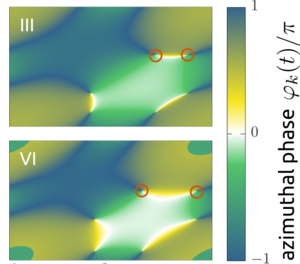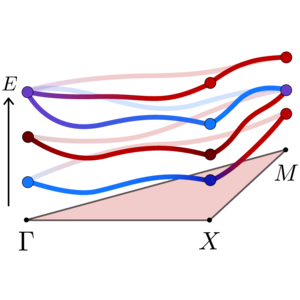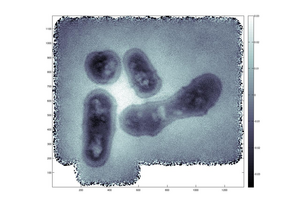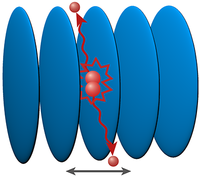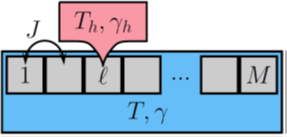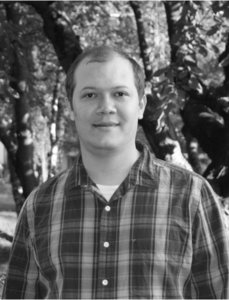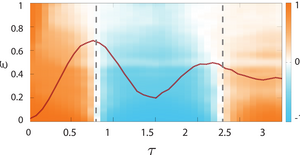
Highlights
Publication Highlights
Dynamical quantum phase transitions: a review
M. Heyl, Rep. Prog. Phys. (2018)
Quantum theory provides an extensive framework for the description of the equilibrium properties of quantum matter. Yet experiments in quantum simulators have now opened up a route towards generating quantum states beyond this equilibrium paradigm. While these states promise to show properties not constrained by equilibrium principles such as the equal a priori probability of the microcanonical ensemble, identifying general properties of nonequilibrium quantum dynamics remains a major challenge especially in view of the lack of conventional concepts such as free energies. The theory of dynamical quantum phase transitions attempts to identify such general principles by lifting the concept of phase transitions to coherent quantum real-time evolution. This review provides a pedagogical introduction to this field. Starting from the general setting of nonequilibrium dynamics in closed quantum many-body systems, we give the definition of dynamical quantum phase transitions as phase transitions in time with physical quantities becoming nonanalytic at critical times. We summarize the achieved theoretical advances as well as the first experimental observations, and furthermore provide an outlook onto major open questions as well as future directions of research.
Read moreQuantum theory provides an extensive framework for the description of the equilibrium properties of quantum matter. Yet experiments in quantum simulators have now opened up a route towards generating quantum states beyond this equilibrium paradigm. While these states promise to show properties not constrained by equilibrium principles such as the equal a priori probability of the microcanonical ensemble, identifying general properties of nonequilibrium quantum dynamics remains a major challenge especially in view of the lack of conventional concepts such as free energies. The theory of dynamical quantum phase transitions attempts to identify such general principles by lifting the concept of phase transitions to coherent quantum real-time evolution. This review provides a pedagogical introduction to this field. Starting from the general setting of nonequilibrium dynamics in closed quantum many-body systems, we give the definition of dynamical quantum phase transitions as phase transitions in time with physical quantities becoming nonanalytic at critical times. We summarize the achieved theoretical advances as well as the first experimental observations, and furthermore provide an outlook onto major open questions as well as future directions of research.
Publication Highlights
Topological Classification of Crystalline Insulators through Band Structure Combinatorics
Jorrit Kruthoff et al., Phys. Rev. X 7, 041069
Topological insulators are exotic materials that are electrical insulators in their interior but can conduct electricity on their surface, and their discovery has fundamentally changed our understanding of how phases of matter may be organized. Most phases of matter are categorized by the symmetries that they break. Crystals break translational symmetry, magnets break rotational symmetry, and so on. Topological insulators, however, show that some phases can be distinct even though their symmetries are equal. Researchers have come up with a classification scheme--called the tenfold way--which allows for the categorization of topological phases depending on some general properties, such as whether or not they have time-reversal or particle-hole symmetry. We complement this categorization by providing a method for listing all possible topologically distinct phases of matter that do not have external symmetries but do have the types of internal (or lattice) symmetries that appear in the atomic arrangements of real solid materials. We explicitly list all possible phases in two-dimensional materials and provide an intuitive and easily applicable method for identifying the phases possible within a given lattice type in any dimension. Our method matches the known results based on the mathematically involved predictions of K-theory, which is known to be a rigorous way of identifying all possible topological phases. It thus provides insight into this mathematical arena based on a physical understanding of topological band structures. We also show how our method can be used to study the transitions between topological phases and predict whether they will result in topologically protected Weyl semimetals. This new classification can now be used to guide the search for new types of topological materials and related edge modes or exotic intermediate phases.
Read moreTopological insulators are exotic materials that are electrical insulators in their interior but can conduct electricity on their surface, and their discovery has fundamentally changed our understanding of how phases of matter may be organized. Most phases of matter are categorized by the symmetries that they break. Crystals break translational symmetry, magnets break rotational symmetry, and so on. Topological insulators, however, show that some phases can be distinct even though their symmetries are equal. Researchers have come up with a classification scheme--called the tenfold way--which allows for the categorization of topological phases depending on some general properties, such as whether or not they have time-reversal or particle-hole symmetry. We complement this categorization by providing a method for listing all possible topologically distinct phases of matter that do not have external symmetries but do have the types of internal (or lattice) symmetries that appear in the atomic arrangements of real solid materials. We explicitly list all possible phases in two-dimensional materials and provide an intuitive and easily applicable method for identifying the phases possible within a given lattice type in any dimension. Our method matches the known results based on the mathematically involved predictions of K-theory, which is known to be a rigorous way of identifying all possible topological phases. It thus provides insight into this mathematical arena based on a physical understanding of topological band structures. We also show how our method can be used to study the transitions between topological phases and predict whether they will result in topologically protected Weyl semimetals. This new classification can now be used to guide the search for new types of topological materials and related edge modes or exotic intermediate phases.
Awards and Honors
"Physik-Preis Dresden“ zum zweiten Mal verliehen
Am Dienstagabend, dem 5. November 2017, wurde der „Physik-Preis Dresden“ der TU Dresden und des Max-Planck-Instituts für Physik komplexer Systeme (MPI-PKS) zum zweiten Mal verliehen. Preisträger ist der französische Physiker Prof. Dr. Jacques Prost, emeritierter CNRS Forschungsdirektor am Institut Curie in Paris.
Prof. Jacques Prost erhielt den Preis für seine herausragenden wissenschaftlichen Verdienste in der Anwendung der Physik des Nichtgleichgewichts auf vielfältige Fragestellungen in der Biologie. Er ist der internationale Pionier in der mesoskaligen Physik biologischer Systeme. Mit seinen originellen und kreativen Ideen hat Jacques Prost neue Konzepte zur Erforschung biologischer Systeme etabliert und die Rolle physikalischer Prinzipen in der Biologie hervorgehoben. Als ein regelmäßiger Gast in Dresden hat er die Entwicklung der Dresdner biophysikalischen Gemeinschaft wesentlich vorangetrieben und zu zahlreichen Forschungsaktivitäten an der Schnittstelle zwischen Physik und Biologie angeregt.
Der Gastgeber des Abends, Prof. Roland Ketzmerick, Sprecher der Fakultät Physik der TU Dresden, war überaus erfreut, dass mit Jacques Prost eine so bedeutende internationale Forscherpersönlichkeit geehrt wurde. „Ich wünsche der Dresdner Biophysik auch weiterhin hervorragende Kooperationen mit ihm“, so Ketzmerick.
Zurzeit arbeitet Prost intensiv an dem Projekt "Physik aktiver Gele und des Zellskeletts" mit Prof. Stephan Grill vom BIOTEC (TU Dresden) und Prof. Frank Jülicher vom MPI-PKS zusammen. Die Auszeichnung mit dem „Physik-Preis Dresden“ sei für ihn eine große Ehre, und er bedankte sich mit einigen deutschen Worten bei Preisstifter Peter Fulde, der Preis-Jury sowie seinen Eltern, die ihn die Bedeutung der Freundschaft innerhalb Europas von Anfang an gelehrt haben. „Ich habe in Dresden echte Freunde gefunden“, betonte Prost.
Der „Physik-Preis Dresden“ wurde 2015 von dem Dresdner Physiker Prof. Peter Fulde, dem Gründungsdirektor des MPI-PKS gestiftet. Die Preisträger werden von einer gemeinsamen Jury der TU Dresden und des MPI-PKS bestimmt, deren diesjähriger Vorsitzender Prof. Dr. Matthias Vojta von der Fakultät Physik ist. Neben dem zentralen Kriterium der wissenschaftlichen Exzellenz ist für die Entscheidung vor allem wichtig, dass die Arbeiten der Preisträger für die Zusammenarbeit zwischen beiden Dresden-concept-Partnern MPI-PKS und TU Dresden von besonderer Bedeutung sind und deren Verbindung langfristig weiter gestärkt wurde.
Read morePublication Highlights
Live cell X-ray imaging of autophagic vacuoles formation and chromatin dynamics in fission yeast
Strelnikova et al., Scientific Reports 7, 13775 (2017)
The major challenge of X-ray imaging of living cellular specimens with a higher resolution than the optical resolution is the very low lethal radiation dose. Owing to the radiation damage and a low electron density contrast, sequential X-ray imaging of live cells was not possible so far. In our manuscript, we demonstrate the first X-ray movies of living yeast cells showing the dynamics of the autophagic vacuole formation and chromosome motion. It is a new way of seeing physiological processes of living organisms at nanoscale resolution. Moreover, the found lower lethal dose for dividing cells in comparison to non-dividing cells, might be an alternative approach to selective killing of malicious cells.
Read moreThe major challenge of X-ray imaging of living cellular specimens with a higher resolution than the optical resolution is the very low lethal radiation dose. Owing to the radiation damage and a low electron density contrast, sequential X-ray imaging of live cells was not possible so far. In our manuscript, we demonstrate the first X-ray movies of living yeast cells showing the dynamics of the autophagic vacuole formation and chromosome motion. It is a new way of seeing physiological processes of living organisms at nanoscale resolution. Moreover, the found lower lethal dose for dividing cells in comparison to non-dividing cells, might be an alternative approach to selective killing of malicious cells.
Publication Highlights
Interaction Dependent Heating and Atom Loss in a Periodically Driven Optical Lattice
Martin Reitter et al., Phys. Rev. Lett. 119, 200402
Time periodic driving, for example in the form of coherent radiation, is a standard tool for the manipulation of small quantum systems like single atoms. With the advent of highly controllable and well isolated quantum gases of neutral atoms, periodic driving has recently become a powerful tool also for the coherent control of many-body systems. A milestone is the possibility to couple the motion of neutral atoms to artificial magnetic fields, which allows to study quantum Hall physics with atomic quantum gases. However, periodically driven many-body systems suffer from unwanted intrinsic heating, the time scale of which should be large compared to the duration of the experiment. In a joint work of Scientists from Munich, Cambridge and Dresden, the interaction dependence of such intrinsic heating has now been measured for the first time and compared to theory. Interestingly, for sufficiently large driving frequencies, heating was found to be reduced via a new form of evaporative cooling.
Read moreTime periodic driving, for example in the form of coherent radiation, is a standard tool for the manipulation of small quantum systems like single atoms. With the advent of highly controllable and well isolated quantum gases of neutral atoms, periodic driving has recently become a powerful tool also for the coherent control of many-body systems. A milestone is the possibility to couple the motion of neutral atoms to artificial magnetic fields, which allows to study quantum Hall physics with atomic quantum gases. However, periodically driven many-body systems suffer from unwanted intrinsic heating, the time scale of which should be large compared to the duration of the experiment. In a joint work of Scientists from Munich, Cambridge and Dresden, the interaction dependence of such intrinsic heating has now been measured for the first time and compared to theory. Interestingly, for sufficiently large driving frequencies, heating was found to be reduced via a new form of evaporative cooling.
Publication Highlights
High-temperature nonequilibrium Bose condensation induced by a hot needle
Alexander Schnell et al., Phys. Rev. Lett. 119, 140602
When a physical system is brought in weak thermal contact with an environment of temperature T, it will appproach an equilibrium state. The properties of this state depend on the temperature of the environment only. For example, a quantum gas of bosonic particles will form a Bose-Einstein condensate, where a macroscopic fraction the particles occupies the same state, below a condensation temperature T_c. In contrast, when a system is coupled to two heat baths of different temperatures T_1 and T_2, the situation changes in a fundamental way. In this case the system will assume a non-equilibrium steady state, which depends on the very details of both baths and not simply on their temperatures. It is an interesting question in how far this fact can be used to manipulate the far-from equilibrium state of the system in a controlled fashion by bath engineering. In this paper, we describe an astonishing effect: a Bose gas that is embedded in an environment of temperature T>>T_c can form a Bose condensate when coupled to a "hot needle", a second local bath of even larger temperature T_h>>T. Moreover, depending on the parameters and unlike in thermal equilibrium, the condensate can also be formed in an excited state of the system.
Read moreWhen a physical system is brought in weak thermal contact with an environment of temperature T, it will appproach an equilibrium state. The properties of this state depend on the temperature of the environment only. For example, a quantum gas of bosonic particles will form a Bose-Einstein condensate, where a macroscopic fraction the particles occupies the same state, below a condensation temperature T_c. In contrast, when a system is coupled to two heat baths of different temperatures T_1 and T_2, the situation changes in a fundamental way. In this case the system will assume a non-equilibrium steady state, which depends on the very details of both baths and not simply on their temperatures. It is an interesting question in how far this fact can be used to manipulate the far-from equilibrium state of the system in a controlled fashion by bath engineering. In this paper, we describe an astonishing effect: a Bose gas that is embedded in an environment of temperature T>>T_c can form a Bose condensate when coupled to a "hot needle", a second local bath of even larger temperature T_h>>T. Moreover, depending on the parameters and unlike in thermal equilibrium, the condensate can also be formed in an excited state of the system.
Institute's News
New Research Group: Fractionalization and Topology in Quantum Matter
We welcome Inti Sodemann as new research group leader! The group will investigate a broad range of topics in quantum matter involving strong interactions, fractionalization, topology, and novel phenomena on spin and charge transport. The problems will be often inspired by experiments. One of the main goals is to develop new approaches to deal with strong interactions and fractionalization in gapless phases of matter.
Read morePublication Highlights
Observation of a dynamical quantum phase transition
Petar Jurcevic et al., PRL 119, 080501
Today, the equilibrium properties of quantum matter are theoretically described with great success. Yet, in recent years pioneering experiments have created quantum states beyond this equilibrium paradigm. Understanding properties of such nonequilibrium quantum states on a general level provides a significant challenge. Jurcevic at el. have now experimentally observed for the first time a phenomenon - a dynamical quantum phase transition - which promises to provide a general framework to identify and predict such general principles of quantum dynamics.
See also the Physics Viewpoint: Quantum Phase Transitions Go Dynamical
Read moreToday, the equilibrium properties of quantum matter are theoretically described with great success. Yet, in recent years pioneering experiments have created quantum states beyond this equilibrium paradigm. Understanding properties of such nonequilibrium quantum states on a general level provides a significant challenge. Jurcevic at el. have now experimentally observed for the first time a phenomenon - a dynamical quantum phase transition - which promises to provide a general framework to identify and predict such general principles of quantum dynamics.
See also the Physics Viewpoint: Quantum Phase Transitions Go Dynamical
Awards and Honors
External Scientific Member Prof. Dr. Peter Grassberger receives EPS Statistical and Nonlinear Physics Prize 2017
for his seminal contributions to nonlinear physics
Read moreAwards and Honors
Edgar Roldan receives EPS-SNPD Early Career prize 2017
for his outstanding contribution in the area of statistical physics and stochastic thermodynamics.
Read more
